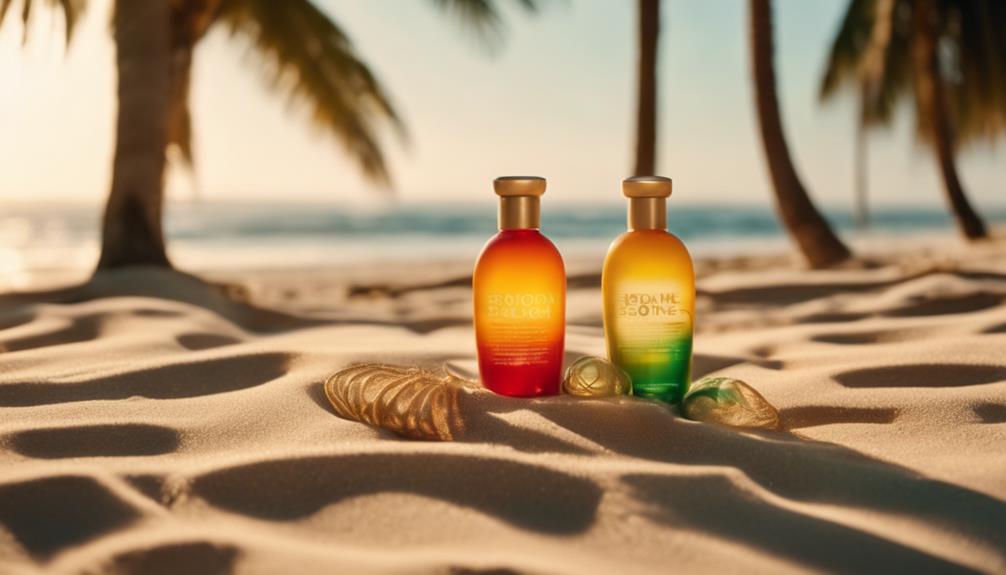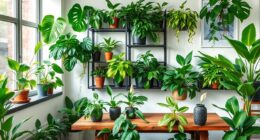To effectively remove tanning oil stains, it is important to act quickly and determine the type of fabric. Gently blot the stain with a clean cloth or paper towel to soak up excess oil. For tougher stains, apply liquid dish soap and let it sit for 5-10 minutes. Wash the item in hot water with a quality detergent, making sure the stain is gone before drying, as heat can set it. For extra stain-fighting power, you may want to try using baking soda or specialized stain removers. These methods can be very effective in restoring your clothing, and there are more tips on stain removal techniques available to you.
Key Takeaways
- Blot fresh tanning oil stains immediately with paper towels to absorb excess oil without spreading.
- Apply liquid dish soap directly onto the stain and let it sit for 5-10 minutes for effective pre-treatment.
- Consider using a heavy-duty laundry detergent or an aerosol stain remover for stubborn, set-in stains.
- Wash the fabric in hot water with quality detergent, checking for residual stains before drying.
Stain Assessment and Initial Actions
When faced with tanning oil stains, it is essential to first assess the fabric type and the age of the stain to determine the most effective cleaning method.
Different fabrics, such as silk or cotton, require distinct approaches due to their varying delicacies. Additionally, the age of the stain plays a critical role; fresh stains are generally easier to treat than older, set-in ones.
Inspecting the size of the stain can also guide the decision on whether spot treatment is sufficient or if professional dry cleaning is necessary. Acting quickly is crucial, as time can worsen the stain's adherence to the fabric.
Start by gently blotting the excess oil with paper towels, pressing down without rubbing to prevent deeper penetration.
Effective Absorption Techniques
Effective absorption techniques are essential for minimizing the impact of tanning oil stains on fabrics, as they help lift the oil before it sets into the material. Implementing the following methods can greatly enhance the effectiveness of oil stain removal:
- Utilize clean cloths or paper towels to gently press against the stain.
- Apply pressure from both sides of the fabric to optimize absorption.
- Avoid rubbing, as this can spread the oil and worsen the stain.
Pre-Treatment Strategies

Pre-treatment strategies are essential for breaking down tanning oil stains and preparing the fabric for thorough cleaning.
Begin by evaluating the fabric type and the age of the stain, as these factors influence the cleaning approach.
For fresh stains, promptly blot the excess oil with paper towels, pressing down gently to avoid deeper penetration.
Next, apply liquid dish soap directly onto the stain, allowing it to sit for 5-10 minutes before rinsing with cold water.
If the stain persists, dab heavy-duty liquid laundry detergent onto the affected area and work it into the fibers.
For stubborn spots, consider using an aerosol stain remover or soaking in a water and oxygen bleach solution prior to washing.
Washing and Drying Methods
Washing and drying methods play an essential role in successfully removing tanning oil stains from fabrics, ensuring that any remaining residue is effectively eliminated. It is vital to follow specific procedures to maximize stain removal:
- Wash stained items in a regular cycle using hot water and a quality detergent.
- For persistent stains, soak the fabric in water mixed with oxygen bleach prior to washing.
- Conduct a thorough spot check post-wash to determine if additional treatments are necessary.
Prevention Tips

To prevent tanning oil stains, it is advisable to apply the oil at least 15 minutes before getting dressed, while using a towel or cover-up as a barrier to minimize direct contact with clothing.
Opting for darker colors or older fabrics can help disguise potential stains, as they tend to be less visible. Additionally, limiting the amount of tanning oil used can greatly reduce the chances of stains occurring.
Regular maintenance of clothing, such as timely washing and proper storage, also plays an essential role in prevention. Educating oneself about fabric care can further enhance stain resistance, ensuring garments remain in ideal condition.
Adopting these proactive measures can help safeguard against unsightly tanning oil stains.
Alternative Cleaning Solutions
Numerous alternative cleaning solutions can effectively address stubborn tanning oil stains on various fabrics. These methods can complement traditional stain removal techniques, providing additional options for effective cleaning.
- Shout Gel Remover: Specifically designed for oils and grease, making it a potent option for tanning oil stains.
- Shampoo: Applying a small amount directly onto the stain can help break down the oil.
- Water and White Vinegar: A mixture of these two can create an effective cleaning solution, harnessing vinegar's acidic properties.
Exploring these alternatives can enhance your stain removal strategy, ensuring a thorough approach to tackling tanning oil stains.
Final Touches for Stain Removal

How can one guarantee that all traces of tanning oil stains are effectively eliminated during the final stages of stain removal?
To ascertain complete removal, closely inspect the stained area after washing. If any residue remains, reapply a heavy-duty detergent or stain remover directly to the affected spot and allow it to sit for an additional 10-15 minutes.
Follow this with another wash cycle, ideally in hot water, to aid in oil breakdown. After washing, refrain from placing the garment in the dryer until you are certain the stain is gone, as heat can set the stain.
Air-drying is preferable for delicate fabrics, allowing for further inspection. Repeat treatments as necessary, and maintain vigilance for any lingering traces.
Can Tanning Oil Stains Be Removed from Clothes After Achieving Post-Tan Paleness?
Unfortunately, removing tanning oil stains from clothes can be a tricky process. However, there are some methods you can try. First, try applying a pre-treatment stain remover to the affected area. Then, wash the garment in the hottest water that is safe for the fabric. If the stain persists, try using a color-safe bleach. The posttan paleness mystery unraveled will have to wait while you focus on removing those pesky stains.
Conclusion
Tanning oil stains pose a significant challenge, particularly on delicate fabrics, with studies indicating that approximately 30% of consumers experience staining issues when using tanning products.
Implementing prompt and effective treatment methods can mitigate the risk of permanent damage to garments.
By understanding appropriate cleaning techniques and preventive measures, individuals can protect their clothing while enjoying the benefits of a sun-kissed appearance.
Ultimately, informed approaches to stain management can guarantee that the pursuit of beauty does not compromise garment integrity.









